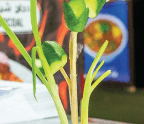The Mirror Test
MELISSA FEBOS
1.
always squeeze bread to make sure it’s fresh; but
what if the baker won’t let me feel the bread?;
you mean to say that after all you are really going
to be the kind of woman who the baker won’t let
near the bread?
—Jamaica Kincaid, “Girl”
In the eighteenth century, “slut’s pennies” were hard nuggets in a loaf of bread that resulted from incomplete kneading. I imagine them salty and dense, soft enough to sink your tooth into, but tough enough to stick. What could a handful of slut’s pennies buy you? Nothing—a hard word, a slap in the face, a fast hand for your slow ones.
A slut was the maid who left dust on the floor—“slut’s wool”—or who left a corner of the room overlooked in her cleaning—a “slut’s corner.” An untidy man might occasionally be referred to as “sluttish,” but for his sloppy jacket, not his unswept floor, because a slut was a doer of menial housework, a drudge, a maid, a servant—a woman.
A slut was a careless girl, hands sunk haphazardly into the dough, broom stilled against her shoulder—eyes cast out the window, mouth humming a song, always thinking of something else.
Oh, was I ever a messy child. A real slut in the making. My clothes tangled on the floor, my books splayed open and dog-eared, their bindings split. At a certain point, when I got in trouble and wanted to be seen as good again, I would clean my room. But only when I wanted to be good, not when I wanted to be clean. I already understood that goodness was something you earned, that existed only in the esteem of others. Alone in my room, I was always good. Or, I was never good. It was not a thing to care about alone in my room, unless I was thinking about the people outside and the ways I might need them to see me.
The story goes like this: In March 1838, Darwin visited the Zoological Society of London’s gardens. The zoo had just acquired Jenny, a female orangutan. The scientist watched a zookeeper tease the ape with an apple. Jenny flung herself on the ground in frustration, “precisely like a naughty child.” Later, he watched her study a mirror in her cage. The visit led him to wonder about the animal’s emotional landscape. Did she have a sense of fairness to offend? Did she feel wronged, and what sense of selfhood would such a reaction imply?
More than a century later, Darwin’s musings led to the mirror test, developed in 1970 by the psychologist Gordon Gallup Jr. It is used to assess an animal’s ability to visually recognize itself. In it, an animal is marked with a sticker or paint in an area it cannot normally see. Then it is shown a mirror. If the animal subsequently investigates the mark on its own body, it is seen to perform this self-recognition. Great apes, Eurasian magpies, bottlenose dolphins, orcas, ants, and one Asian elephant are the most frequently cited animals to have passed the test.
Just think of all the things a woman
You’re reading a preview, subscribe to read more.
Start your free 30 days

